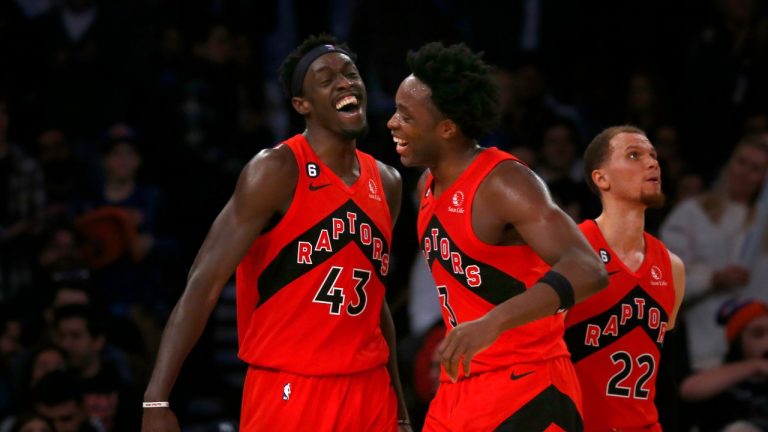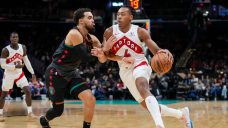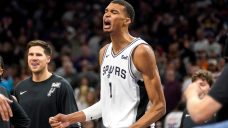TORONTO — Evaluating.
That word has been doing a lot of heavy lifting around the Toronto Raptors organization for the past 12 months or so.
It’s been at least that long since the club seemed to know where it was headed, how it would get there and who would take it.
It’s remarkable, really. Just a year ago, the Raptors were a team coming off a 48-win season (in 2021-22) and featured an all-star point guard in Fred VanVleet, a two-time all-NBA forward in Pascal Siakam, a soon-to-be all-NBA defender in OG Anunoby and the reigning Rookie of the Year and franchise’s favourite son, Scottie Barnes. Three of those four had championship rings, as did then-head coach Nick Nurse, who also had a Coach of the Year award on his resume. They even had a young, proven three-point shooter/microwave scorer in Gary Trent Jr. and all their own draft picks going forward.
Then, at the trade deadline, they added Jakob Poeltl, losing nothing materially from their roster and gaining a quality centre in his prime with whom they already had a longstanding relationship with.
Taken collectively, it would seem — from a distance — to be a significant head start on putting together a team that could be competitive in the Eastern Conference for years, particularly since the oldest of the four players was VanVleet, not yet 30. Add a piece or two, have a player development project pop like in the old days, and all would be right in the Raptors' world.
No one who follows the team closely needs to be told how far off all those seemingly reasonable assumptions have proven to be.
It’s borderline amazing, honestly, but here we are with barely six weeks until the NBA trade deadline and the Raptors remain mired in sub-mediocrity while the shared vision of Raptors president Masai Ujiri, general manager Bobby Webster and the rest of Toronto’s longstanding executive team remains — mostly — as inscrutable as ever.
Granted, that is generally how they like it.
“That’s the thing with [them],” said one Eastern Conference scout. “There are always a lot of smokescreens. You never know what they are thinking.”
In some circumstances, the air of mystery could even be seen as an advantage, a "What do they know that we don’t?" kind of thing.
But given the Raptors' decidedly tepid recent transaction track record — a minimal return in a sign-and-trade for franchise icon Kyle Lowry in the summer of 2021; trading down 13 slots in the 2022 draft to acquire Thad Young at the deadline two seasons ago; trading a (protected) first-round pick and two seconds for Poeltl at the trade deadline last season; and losing VanVleet in free agency for no return last summer — their seeming indecision could be because they themselves haven’t identified a clear path forward.
The one thing that has come into focus this season, even through the fog of a wholly deserved 12-18 record?
The firm belief that Barnes is a cornerstone talent who can lead a team to an NBA championship. For all the bumpiness of the past three-plus seasons, taking Barnes with the fourth pick is the move they feel like they got right. The evidence is playing out this season as Barnes — recently elevated to starting point guard by head coach Darko Rajakovic — is averaging 20.7 points, 9.4 rebounds, 5.9 assists, 1.5 steals and 1.4 blocks while shooting 38.9 per cent from three on more than five attempts a game, all of which have him on pace to blow away previous career highs. He leads what was considered to be a strong 2021 draft class in most advanced metrics. As much promise as the players taken ahead of him — Cade Cunningham, Jalen Green and Even Mobley — have shown, Barnes might well be the first pick in the draft if it were done over today.
It follows, then, that the plan going forward is as simple — and complicated — as figuring everything else around Barnes.
In that context, it’s safe to conclude — and the Raptors have indicated as much to league insiders I’ve spoken with — that there is no appetite for a reset, teardown or rebuild.
Even presuming Barnes signs a designated rookie extension next summer, which would keep him under contract for a total of six seasons (presuming there are no opt-outs) beginning in 2024-25, the idea of wasting the early years of Barnes’ prime by selling off parts for draft picks isn’t being entertained. Tanking for Cooper Flagg — the runaway leading No. 1 prospect for the 2025 NBA Draft — is not in the plan.
Which makes the situation around pending free agents Pascal Siakam, OG Anunoby and — to a lesser extent — Trent Jr. (who hasn’t been part of any extension discussions, per sources) so fascinating, and critical. Presuming the Raptors stick with the lineup they used against the Washington Wizards on Wednesday night, that means the futures of three of the starters around their franchise cornerstone remain completely up in the air.
To start with, not in the plan for the moment is an extension for Siakam, who can sign with Toronto for up to four years and $192 million until June 30. There have been framework-type conversations since the early days of the season, per league sources, and each side has eyed Dec. 30 as a potential impetus to reach a decision. Given that no agreement has been reached, it seems safe to infer the Raptors' interests lie in something closer to the three-year extension that they offered at the beginning of the 2022-23 season that Siakam rejected.
The logic being that signing Siakam to an extension before the new year would allow the Raptors to keep one of the best players in franchise history — Siakam and Lowry are the only two players to rank in the top five in scoring and assists — under contract while also preserving the flexibility of trading him next summer if the moment presented itself.
If an extension isn’t reached, then trading Siakam by Dec. 30 might offer some advantages to the acquiring team because it would have a window before free agency begins on July 1 to reach an agreement on a four-year extension using Siakam’s Bird Rights — he would be considered the team's own free agent, and his deal wouldn’t have to fit under the salary cap.
If Siakam isn’t traded or extended by Saturday, the Raptors would still be able to sign him to an extension but wouldn’t be able to trade him until six months past the signing date, which could complicate any plans or opportunities that may emerge around the draft and the opening of free agency next summer.
If they don’t extend Siakam and trade him before the Feb. 9 trade deadline, then the acquiring team would have to be assured it could sign Siakam as a free agent before including its best trade assets. No one is going to pay top dollar for a half-season of work from a player who could leave in free agency.
Things can change with a phone call, but the sense is that there is no momentum for any kind of decision regarding Siakam over the coming days, which increases the likelihood that the eight-year veteran doesn’t get moved at all, or it means that the pool of teams Siakam does get traded to is limited to those that Siakam would agree to sign with long term.
As for Anunoby? He remains a player teams are interested in, both as a trade target and potential free agent. The Indiana Pacers have interest in Siakam and Anunoby, per league sources, as an example. Given Anunoby’s simple fit as an elite multi-positional defender who can play off the ball and space the floor, the list of quality teams that could find room for him in their starting lineup is long.
For the same reason — and given that he’s only 26 — Anunoby would also seem like an excellent long-term fit alongside Barnes.
In a perfect world, the Raptors would keep both Siakam and Anunoby as a core around Barnes and find better and more complementary pieces to slot around their most accomplished players.
But the how is the problem, remains the problem and has been the problem.
In the past 12 months, the Raptors have convinced themselves they’ve found their franchise-defining superstar.
But still unresolved is the best way to support his trajectory with a roster that is on pace to finish 11th in the Eastern Conference, even while Barnes is having a career season and Siakam and Anunoby are playing — for the most part — close to their peak levels, and the roster as a whole has been remarkably healthy.
Is supporting Barnes’ development best done by finding a way to keep both Siakam and Anunoby? Trading one for young talent who can grow with him, while keeping one established veteran to play with him? If so, which one should get moved? Or how about trading both Siakam and Anunoby and transforming the Raptors overnight into a team with depth, youth and draft assets, but short on established players with track records of success?
The Raptors — as always it seems — have plenty to evaluate.








COMMENTS
When submitting content, please abide by our submission guidelines, and avoid posting profanity, personal attacks or harassment. Should you violate our submissions guidelines, we reserve the right to remove your comments and block your account. Sportsnet reserves the right to close a story’s comment section at any time.